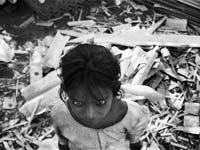Tax dollars used to send ‘killer’ to Asia

A government loan to revive one of Canada’s last asbestos mines and assure exports of the controversial fireproofing fibers for another 20 years will kill thousands in Asia; say medical professionals and global anti-asbestos crusaders.
Asbestos exposure has been linked with lung and other cancers. An estimated 90,000 people die from asbestos-related illnesses every year, according the World Health Organization.
The province of Quebec said last week it would put up $58 million toward renovating and reopening the Jeffrey Mine in Asbestos, after it was closed last year due to financial setbacks.
Private investors will kick in another $25 million.
The Jeffrey Mine and the nearby Thetford Mine were Canada’s last two operating asbestos mines. Their closures marked the first time in 130 years that Canada, which once dominated world production, had suspended production of the mineral.
Canada is the world's fifth largest exporter of chrysotile asbestos. The two mines in the province of Quebec account for all of the production.
According to the last figures available, Canada exported 750,000 tons of asbestos in 2006.
India, Indonesia, China and the Philippines, among others, have been major importers of Canadian asbestos. In contrast, Canada uses almost no asbestos within its borders,
The fibrous crystal mineral is primarily used as building insulation because of its sound absorption and resistance to fire, heat and electrical damage but exposure to it can cause lung inflammation and cancer.
The Canadian Medical Association, the Canadian Public Health Association and the National Specialty Society for Community Medicine have demanded that provincial and federal governments stop funding the asbestos industry and promoting Canadian asbestos abroad saying the asbestos imported from Quebec mines is a major contributor to this death toll.
In India, where more than 300,000 tonnes of asbestos was imported in 2007, chrysotile asbestos is routinely used in roofing, and no license is required to import the mineral, according to The Lancet, a British health journal.
According to the Asian Ban Asbestos Network, the ratio of asbestos exported to Asia has increased from 70 percent to 86 percent of the global output over the past 12 years.
An investigation conducted by the International Consortium of Investigative Journalists (ICIJ) and aired by BBC found that the asbestos industry has ignored waves of asbestos-related disease that have led to bans or restrictions in 52 countries, and continues to ply the mineral in developing nations.
Most of the asbestos sold in those countries is used in cement for corrugated roofing, in water pipes and for home construction.
Chrysotile is another name for the most common type of asbestos, white asbestos.
The Montreal-based Chrysotile Institute promotes the “controlled” use of asbestos in construction and manufacturing, a concept critics say is “elusive in developing countries,” where worker safety regulations are lax and more and more people are being exposed to asbestos.
The industry campaign is likely to result in epidemics of asbestos-related diseases within the next decade, with the biggest users, China and India, the hardest hit by the mineral’s devastating health effects.
Researchers in India have estimated that deaths from asbestos-related cancers could reach one million in developing nations by 2020, while an Australian researcher has predicted five to 10 million deaths from cancers caused by asbestos exposure by 2030.
Finnish researchers estimated that 10,000 to 15,000 people will die in China each year by 2035 of asbestos-related ailments.
Currently, the death toll from asbestos-related diseases is estimated by the International Labor Organization to be 100,000 worldwide.
Perhaps nowhere is the industry as strong as in Gujarat, India
At one company alone in Ahmedabad — Gujarat Composite Ltd. — a at least 75 workers have been diagnosed with lung cancer in the past 10 years, out of a work force of about 1,000, according to nongovernmental activists in Ahmedabad who are working on asbestos-related diseases. At least 20 of those have died, they said.
“The asbestos market — despite being a health hazard — has grown because it serves the market for the poor,” said Gopal Krishna of the Ban Asbestos Network of India. “And that market is growing at a tremendous pace. So nobody has the time for complaints.”
In India, asbestos products carry little or no health warning labels and trade unions have no mandate to prevent asbestos-related disease at workplaces.
Although researchers around the world have linked lung cancer and other diseases with exposure to the widely used white, or chrysotile, asbestos, the powerful Asbestos Cement Products Manufacturers Association — funded by 12 asbestos companies, as well as by the Canada-based Chrysotile Institute — concedes nothing.
The Chrysotile Institute contends that lung cancer deaths have been caused by inhaling asbestos fiber has not been conclusively proved in India.
It states chrysotile asbestos is less toxic than blue or brown forms of the mineral, which no longer are used.
Leave a comment









